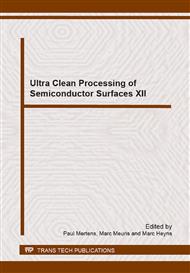p.128
p.131
p.134
p.138
p.143
p.148
p.153
p.157
p.161
Novel Slurry Injection System for Improved Slurry Flow and Reduced Defects in CMP
Abstract:
In commercial CMP tools, slurry is applied near the pad center. As the pad rotates, more than 95% of the fresh slurry flows directly off the surface due to bow wave formation and inertial forces without ever entering the pad-wafer interface, resulting in low slurry utilization [1]. Furthermore, some slurry that manages to go under the wafer stays on the pad, mixes with fresh slurry and re-enters the pad-wafer interface. This used slurry contains reaction products, foam and pad debris (due to pad conditioning) that cause wafer-level defects [2]. Such defect-causing by-products keep recirculating on the pad during polishing and accumulate near the retaining ring over time. Also, since large amounts of DI water are used between wafer polishes to rinse off the debris and reaction products, appreciable amounts of water may stay on the pad and inside the grooves. When fresh slurry is introduced to polish the next wafer, it mixes with the residual water and is diluted, resulting in lower material removal. As such, the current slurry application method does not provide efficient slurry utilization and leaves significant room for improving defect levels. Moreover, the constant sweeping of the conditioner arm during in-situ conditioning results in uneven slurry distribution and introduces additional challenges when it comes to carrier multi-zone pressure control for reduced within-wafer removal rate non-uniformity.
Info:
Periodical:
Pages:
143-147
Citation:
Online since:
September 2014
Authors:
Keywords:
Price:
Сopyright:
© 2015 Trans Tech Publications Ltd. All Rights Reserved
Share:
Citation:


